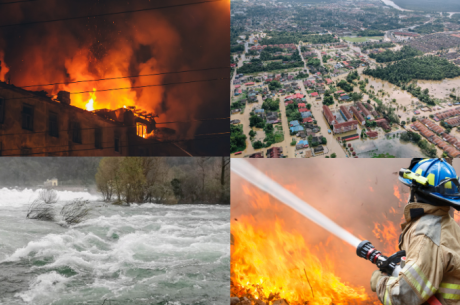Natural disasters can strike at any moment, leaving us vulnerable and unprepared. In this comprehensive guide, we’ll delve into the essential aspects of Natural Disasters: What to Know and How to Respond. From proactive measures to on-the-spot decision-making, empower yourself with the knowledge to navigate these challenging situations.
Understand the Gravity of Natural Disasters
Understanding the gravity of natural disasters is crucial for assessing their impact on human societies, the environment, and infrastructure. Natural disasters, such as earthquakes, hurricanes, floods, tornadoes, and wildfires, can have devastating consequences that extend far beyond the immediate event. Here are some key aspects to consider:
- Human Impact:
- Loss of Life: Natural disasters can result in the tragic loss of human lives. Earthquakes, tsunamis, and hurricanes, for example, can cause widespread destruction and casualties.
- Injuries and Trauma: Survivors may suffer injuries, both physical and psychological, which can have long-lasting effects on individuals and communities.
- Infrastructure Damage:
- Buildings and Homes: Earthquakes, hurricanes, and floods can cause extensive damage to buildings and homes, leading to displacement of communities and economic losses.
- Transportation Networks: Natural disasters can disrupt transportation systems, making it challenging for emergency response teams to reach affected areas and hindering evacuation efforts.
- Environmental Consequences:
- Ecosystem Disruption: Wildfires and floods can lead to the destruction of ecosystems, affecting plant and animal life and disrupting the balance of natural habitats.
- Pollution and Contamination: Some disasters, such as floods and hurricanes, can lead to the release of pollutants and contaminants, posing risks to water and air quality.
- Economic Impact:
- Financial Losses: The economic impact of natural disasters is significant. Rebuilding efforts, loss of productivity, and the need for emergency response resources contribute to substantial financial burdens on affected regions and countries.
- Job Displacement: Businesses may be forced to close, leading to job losses and economic hardship for individuals and communities.
- Social and Community Disruption:
- Displacement and Homelessness: Natural disasters can displace large populations, leading to temporary or even long-term homelessness.
- Social Disruption: Communities may face social challenges, including strained healthcare systems, difficulties in education, and an increased risk of social unrest.
- Climate Change Connection:
- Exacerbation of Climate Change: Some natural disasters are linked to climate change, and their frequency and intensity may increase as a result of global warming. This highlights the interconnectedness between natural disasters and broader environmental issues.
- Preparedness and Mitigation:
- Importance of Preparedness: Understanding the gravity of natural disasters underscores the importance of proactive measures such as early warning systems, emergency preparedness plans, and community resilience strategies.
- Mitigation Strategies: Efforts to mitigate the impact of natural disasters include sustainable land-use planning, building resilient infrastructure, and addressing climate change through emissions reduction.

Types of Natural Disasters
- Earthquakes: Earthquakes result from the sudden release of energy in the Earth’s crust, leading to ground shaking. They can cause widespread destruction and are often accompanied by aftershocks.
- Floods: Floods occur when water exceeds normal levels, submerging land. This can result from heavy rainfall, storm surges, or the rapid melting of snow or ice.
- Wildfires: Wildfires are uncontrolled fires that spread rapidly through vegetation. They are often fueled by dry conditions, high winds, and flammable materials.
- Hurricanes (or Typhoons/Cyclones): These are powerful tropical storms with strong winds and heavy rainfall. They form over warm ocean waters and can cause extensive damage when they make landfall.
- Tornadoes: Tornadoes are violent windstorms characterized by a twisting, funnel-shaped cloud. They can cause localized but intense damage with their high winds.
- Droughts: Droughts result from extended periods of below-average rainfall, leading to water shortages. They can have severe impacts on agriculture, water supply, and ecosystems.
- Landslides: Landslides involve the movement of rock, soil, and debris down a slope. They can be triggered by heavy rainfall, earthquakes, volcanic activity, or human activities.
- Tsunamis: Tsunamis are large ocean waves typically caused by undersea earthquakes or volcanic eruptions. They can travel across entire ocean basins, causing widespread coastal damage.
- Blizzards: Blizzards are severe snowstorms with strong winds and reduced visibility. They can lead to snowdrifts, transportation disruptions, and cold-related emergencies.
Signs and Early Warnings
Recognizing signs and receiving early warnings are critical components of staying safe in the face of natural disasters. Being able to identify these indicators allows individuals and communities to take prompt action, potentially saving lives and minimizing damage. Here are key aspects related to signs and early warnings:
Earthquakes:
Signs:
- Ground Shaking: Tremors or vibrations may precede a larger earthquake.
- Strange Sounds: Unusual noises like rumbling or roaring may occur.
Early Warnings:
- Seismic Sensors: Advanced monitoring systems can provide seconds to minutes of warning.
- Animal Behavior: Animals might exhibit unusual behavior before an earthquake.
Floods:
Signs:
- Rising Water Levels: Increased water levels in rivers or streams.
- Heavy Rainfall: Prolonged and intense rain can lead to flooding.
Early Warnings:
- Weather Alerts: Meteorological agencies issue warnings based on forecasted heavy rainfall.
- River Gauges: Monitoring stations can indicate rising water levels.
Wildfires:
Signs:
- Smoky Smell: The scent of smoke in the air.
- Visible Flames: Flames or glow on the horizon.
Early Warnings:
- Fire Weather Alerts: Issued during conditions conducive to wildfires.
- Satellite Imagery: Detects areas of increased heat or smoke.
Hurricanes:
Signs:
- Increasing Wind Speeds: Gradually intensifying winds.
- Gathering Clouds: Dark clouds and changing sky patterns.
Early Warnings:
- Meteorological Advisories: Predictions and tracking by weather agencies.
- Evacuation Orders: Authorities may issue orders in the storm’s path.
Tornadoes:
Signs:
- Dark, Greenish Sky: Unusual coloration in the sky.
- Rotating Funnel Cloud: Visible rotating column of air.
Early Warnings:
- Tornado Watches/Warnings: Issued by meteorological services.
- Weather Sirens: Activated to alert communities.
Early Warnings:
- Volcanic Monitoring: Seismic instruments and gas sensors provide data.
- Evacuation Alerts: Issued based on volcanic activity assessment.
Emergency Kits: What You Need to Include
Basics:
- Water Supply: Ensure you have at least one gallon of water per person per day for at least three days.
- Non-Perishable Food: Stock up on canned goods, energy bars, and other non-perishable items to sustain you during emergencies.
- First Aid Kit: Include bandages, antiseptic wipes, pain relievers, and any necessary prescription medications.
- Flashlights and Batteries: Illuminate the dark with reliable flashlights and a surplus of batteries.
- Multipurpose Tool: A tool with various functions, like a Swiss Army knife, can prove invaluable.
- Personal Hygiene Items: Maintain sanitation with items like toothbrushes, toothpaste, and sanitary supplies.
Important Documents:
- Identification: Have copies of personal identification, passports, and driver’s licenses.
- Insurance Policies: Keep copies of insurance documents for quick access.
- Medical Records: Include records of vaccinations, allergies, and medical conditions.
- Emergency Contact Information: Compile a list of essential contacts, including family, friends, and emergency services.
Evacuation Plans: Strategizing for Safety
Establish Evacuation Routes:
- Local Maps: Familiarize yourself with local maps, highlighting evacuation routes and shelters.
- Designated Meeting Points: Choose meeting points for family members in case of separation.
Communication Strategies:
- Emergency Contacts: Ensure everyone has a list of emergency contacts saved in their phones.
- Portable Chargers: Keep portable chargers to maintain communication devices.
Consider Special Needs:
- Medical Requirements: Account for any special medical needs or equipment.
- Pet Supplies: If applicable, pack necessities for pets, including food and water.
Regular Revisions:
- Kit Expiry Checks: Regularly check and replace expired items in your emergency kit.
- Updated Information: Keep contact information and evacuation routes up to date.
Practice and Drills:
- Mock Evacuations: Conduct periodic drills to ensure everyone is familiar with evacuation procedures.
- Review with Family: Discuss and review plans with family members regularly.
Conclusion
Navigating the challenges posed by natural disasters requires a combination of knowledge, preparedness, and community support. By understanding “Natural Disasters: What to Know and How to Respond,” you empower yourself to face these events with resilience and strength. In times of recovery, consider reaching out to local resources like PuroClean of Pembroke Pines for expert assistance. Their dedicated services can provide the support and expertise needed to restore and rebuild, ensuring a smoother journey toward recovery for you and your community.
Frequently Asked Questions (FAQs)
How can I prepare my family for a natural disaster?
Ensure your family’s safety by creating a comprehensive emergency plan. Include evacuation routes, communication strategies, and designated meeting points.
What should I include in my emergency kit?
An emergency kit should contain essentials like non-perishable food, water, first aid supplies, important documents, and personal medications.
How do I secure my home against earthquakes?
Secure heavy furniture, appliances, and fragile items. Additionally, invest in earthquake-resistant building measures to minimize structural damage.
How can communities come together during disaster recovery?
Community support is vital. Engage in local disaster preparedness initiatives, fostering unity and collaboration for effective recovery.
What emotional support is available after a natural disaster?
Seek counseling services, connect with support groups, and prioritize self-care. Emotional well-being is as crucial as physical safety.
How can I contribute to disaster relief efforts?
Donate to reputable organizations, volunteer your time, or organize community fundraisers. Every contribution makes a significant impact.




 PuroClean of Ft. Lauderdale South
PuroClean of Ft. Lauderdale South